
The Wood for the Trees
Someone should perhaps write a book about the things distinguished scientists get up to when they retire. Thomas Huxley withdrew from greater scientific affairs to take up alpine flowers, and it is perhaps a shame that he never wrote a book about them. Richard Fortey FRS (former President of the Society and Senior Palaeontologist at the Natural History Museum), finding the proceeds from a TV series burning a hole in his pocket, decided that he would buy Grim’s Dyke Wood, four acres of Chiltern woodland not far from his native Henley.
He made it a project, and proceeded to study the wood’s every aspect: geological, archaeological, historical, botanical, mycological and zoological. The result is this delightful amalgam of natural and human history - Geoscientist’s recommended summer read – which underlines a point dear to my own heart, which is that you can tell the history of the world from any locality on its surface – like William Blake, seeing the world in a grain of sand.
Using a ‘country diary’ approach to describe life on the edge (of a Chalk escarpment), each chapter covers a different month. Fortey then draws in his many themes in due season – his beloved fungi in November, moths in June, and so on, dragooning a dazzling array of experts to help him lend weight and detail to his observations. Finally, true museum man that he is, he harvests some cherry wood, cuts it into planks which he seasons himself, and commissions a beautiful bespoke ‘cabinet of curiosities’ in which to keep his notebook and all the interesting bits and bobs he accumulates during the year.
Fortey is one of those lucky writers who makes his readers wish they knew him better, that they could spend time with him in tweedy pursuits, bumbling about in Grim’s Dyke, getting their knees wet from leaf mould, sitting on fallen logs and making natural historical notes in leather-bound books. Never has the author’s whimsical, woollyjumpery, Brysonesque, and (now and then) donnishly testy personality come over quite as faithfully as it does in The Wood for the Trees.
He says in the introduction that it is a book ‘both romantic and forensic, if such a combination is possible’. What follows surely proves that it is; that the status of beech tree and liverwort are indeed compatible with the play of the light; the passage of the seasons and people with the ‘incomparable pleasures of discovery’.
Indeed, as his focus widens, Fortey’s confidence as a writer seems to grow – to the point of including culinary suggestions and recipes (a hallmark of his TV appearances), and even to using the word ‘questing’ far more often than any other nature writer might have dared. After Evelyn Waugh’s ridicule of the genre through the inept pen of his hapless journalist character William Boot (author of the deathless line: ‘
Feather-footed through the plashy fen passes the questing vole’) this also constitutes ‘life on the edge’.
Reviewed by Ted Nield
THE WOOD FOR THE TREES – THE LONG VIEW OF NATURE FROM A SMALL WOOD by RICHARD FORTEY. William Collins 2016 ISBN 978-0-00-810466-5 306pp Hbk List Price: £22.00 W: www.harpercollins.co.uk
Four Billion Years and Counting: Canada's Geological Heritage
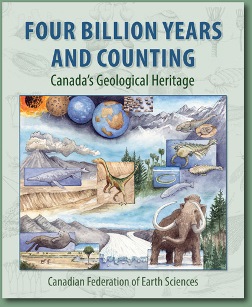 Before agreeing to review this book I did a quick Internet search just to see if it has a mention, what price it might be and frankly if it was worth reviewing. What I found there was a revelation! *
Before agreeing to review this book I did a quick Internet search just to see if it has a mention, what price it might be and frankly if it was worth reviewing. What I found there was a revelation! *
On another site one of the authors explained the origin of the book: “One day last summer, a 40-ish well-educated woman visited our house. … She asked me about my professional background and I told her that I am an Earth scientist. She looked puzzled and said: ‘and what do you do with that, other than teach?’ I was dumbstruck… then noticed her nice shiny and stylish watch and said ‘well, let’s begin with your watch, where do you think its component materials came from?’”
Thus began what can be described as a tour de force [the book comes in English and French] of geological outreach. Although written from a Canadian perspective, it has a wide, immediate and absorbing interest for geologists of all levels. The standard of the material is superlative with high quality colour photographs, illustrations and artistic recreations added to a crystal clear language. It describes the technicalities of our subject in a way which focuses effortlessly upon the core message: geology matters. It is a masterpiece of good communication.
There are 20 chapters in three parts, covering foundations [of the science], the Evolution of Canada [but not just Canada] and Wealth and Health [the way that geology is used]. Each chapter is quite short and to the point and written by a phalanx of skilful authors. The whole thing has been funded by five major supporters and the chapters by 20 or so backers, indeed a very impressive collaborative effort. It is a good read at an extremely reasonable price.
On the other hand, will the ‘40-ish well educated woman’ buy it and read it? Perhaps it’s up to you to recommend it to those who might be in need, and then you can borrow it back! I’m just a little surprised that Air Canada did not part-fund the book because once you have this in your hands then you may well be on your way to Banff quite soon.
*For links, see online version of this review in the 2015 collection. Editor
Reviewed by Arthur Tingley
FOUR BILLION YEARS AND COUNTING - CANADA’S GEOLOGICAL HERITAGE - Eds: FENSOME R, WILLIAMS G, ACHAB A, CLAGUE J, CORRIGAN D MONGER J, NOWLAN G. Nimbus 2014 Canadian Federation of Earth Sciences. Reprinting June 2016. ISBN: 9781551099965. W: www.fbycbook.com/#!home/mainPage
Microbial Carbonates in Space and Time
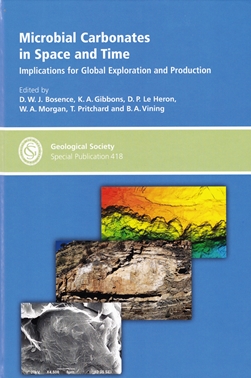 Recent discoveries in ‘unconventional’ carbonate reservoirs such as the Lower Cretaceous pre-salt of the Campos Basin, offshore Brazil have stressed the importance of research into microbial carbonate (microbialite) deposits. This Special Publication not only succeeds in compiling a diverse range of 14 papers on the economic importance of microbialites; it also manages to place such deposits in a context that those with a background in carbonate sedimentology can appreciate.
Recent discoveries in ‘unconventional’ carbonate reservoirs such as the Lower Cretaceous pre-salt of the Campos Basin, offshore Brazil have stressed the importance of research into microbial carbonate (microbialite) deposits. This Special Publication not only succeeds in compiling a diverse range of 14 papers on the economic importance of microbialites; it also manages to place such deposits in a context that those with a background in carbonate sedimentology can appreciate.
Microbialite deposits are found throughout the geological record, the book addressing this with a series of case studies that spans the Neoproterozoic to the Cenozoic. The papers in each section are varied, including facies association, stratigraphic architecture and petrophysics. Each paper complements the others, with work ranging from microscopic to seismic scale. A pleasantly surprising inclusion is that of work on seismic and core from the Campos Basin microbialite discoveries. The decision of companies operating offshore Brazil to release data into the public domain is an important one, as it allows those with an interest to finally study these previously ‘classified’ and enigmatic deposits.
Overall, the quality of the publication is excellent, with most figures reproduced in colour. Each paper is well written with clear, engaging illustrations. Of particular note is a paper on Ediacaran microbial carbonates, which contains eye-catching annotated field photographs and schematic models that are a joy to read. As a minor point, some papers are printed in black and white and although not illegible, certain figures may lack the impact of those printed in colour.
This comprehensive SP is an ideal starting point for anyone interested in microbial carbonates. It effectively summarises the combined knowledge of academia and industry, and is applicable to both. At present, most readers will be postgraduates already involved in related studies. However, in the future this book will become increasingly relevant to undergraduates as frontier microbialite plays become the norm in the oil and gas industry. This work will undoubtedly pave the way for exciting developments in our understanding of a long overlooked section of carbonate sedimentology.
Reviewed by Jack Stacey
MICROBIAL CARBONATES IN SPACE AND TIME: IMPLICATIONS FOR GLOBAL EXPLORATION AND PRODUCTION by: D W J BOSENCE, K A GIBBONS, D P LE HERON, W A MORGAN, T PRITCHARD AND B A VINING. Geological Society Special Publication 418 (hbk). ISBN: 9781862397279. List Price: £90. Fellows Price: £45. W: www.geolsoc.org.uk/SP418
Geodiversity
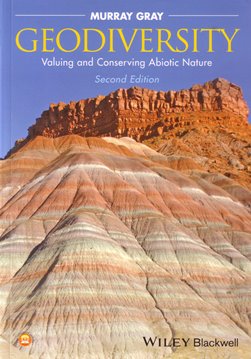 To quote the author, this book ‘is about the value of difference, diversity and distinctiveness in the natural world’. It uses geological and geomorphological diversity – geodiversity – as a demonstration of this variety and sets out the intimate relationship and influence of geodiversity on our world: its evolution, changing landscapes and biodiversity, and our own history, culture and well-being. Following the simple formula ‘value + threat = conservation’ Murray Gray establishes the value and importance of geodiversity, demonstrates that geodiversity is threatened and then sets out how geodiversity is conserved, reflecting both established approaches and new concepts in geoconservation.
To quote the author, this book ‘is about the value of difference, diversity and distinctiveness in the natural world’. It uses geological and geomorphological diversity – geodiversity – as a demonstration of this variety and sets out the intimate relationship and influence of geodiversity on our world: its evolution, changing landscapes and biodiversity, and our own history, culture and well-being. Following the simple formula ‘value + threat = conservation’ Murray Gray establishes the value and importance of geodiversity, demonstrates that geodiversity is threatened and then sets out how geodiversity is conserved, reflecting both established approaches and new concepts in geoconservation.
This is the second edition and much has changed since the first was published in 2004. Notably global geoconservation effort, co-operation and profile have seen significant development. Here perhaps the greatest advance has been in relation to Geoparks. In 2004 this was a relatively new initiative with 15 European Geoparks. Now worldwide there are 120 Global Geoparks recognised in 33 countries and, as of 2015, the ‘UNESCO Global Geopark’ has become the first new UNESCO designation in over 40 years.
There has also been a gradual shift in emphasis. The established protected area approach remains (for example in the UK: World Heritage Site, National Park, Site of Special Scientific Interest and Local Geological Site) but alongside there is a growing realisation of the importance of taking a wider and more integrated approach. Gray examines in detail the role of geodiversity as an ‘ecosystem service’, considers different approaches to landscape characterisation (which all use geodiversity as a fundamental character) and discusses the importance of integrating geodiversity and biodiversity conservation.
My view remains that the greatest challenge for geoconservation is the value placed on geodiversity (and therefore the need for its conservation). Here Gray has made a significant contribution. The term ‘geodiversity’ has gained global traction and this second edition will continue this growth: a plethora of new examples of geoconservation in practice make this the most comprehensive account of geodiversity and geoconservation (from a global to a local level) to date.
For anyone (geologist or not) who wishes to make the case for geodiversity and geoconservation then this is highly recommended reading and, if you own the first edition, don’t worry - the second is an invaluable companion.
Reviewed by Jonathan Larwood
GEODIVERSITY: VALUING AND CONSERVING ABIOTIC NATURE 2nd Edn, by MURRAY GRAY, 2013. Published by: Wiley Blackwell 508pp ISBN 978-0-470-74215-0 (sbk) List price: £37.50
Volcanism and Global Environmental Change
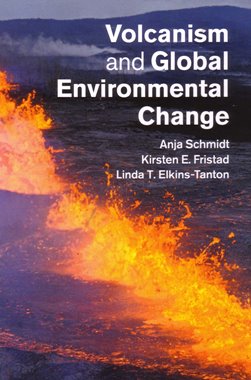 The publication of this book comes on the back of the 2010 eruption of Eyjafjallajökull which raised in the general public’s consciousness the potential of volcanic eruptions to affect our climate, environment and how we go about our daily lives. This multidisciplinary volume is divided into three parts; the first focuses on the origins, features and timing of large volume volcanism; the second on assessing gas and tephra release both in the present day and paleo-record; and the third deals with modes of volcanically induced global environmental change. The 20 chapters are a mixture of recent advances in the field and broader reviews, supported generously with monochromatic illustrations, figures and diagrams, as well as a central section of colour figures.
The publication of this book comes on the back of the 2010 eruption of Eyjafjallajökull which raised in the general public’s consciousness the potential of volcanic eruptions to affect our climate, environment and how we go about our daily lives. This multidisciplinary volume is divided into three parts; the first focuses on the origins, features and timing of large volume volcanism; the second on assessing gas and tephra release both in the present day and paleo-record; and the third deals with modes of volcanically induced global environmental change. The 20 chapters are a mixture of recent advances in the field and broader reviews, supported generously with monochromatic illustrations, figures and diagrams, as well as a central section of colour figures.
The main message is that some large past eruptions (e.g. continental flood basalts) had global impacts affecting climate and environmental chemistry and potentially triggering mass extinctions; not every eruption instigates major environmental change however, and the mechanisms which control different modes of volcanism and their range of associated environmental effects are the subject of ongoing research. Gas and aerosol particles from highly explosive and volumetrically large eruptions have the potential to circulate in the stratosphere, causing hemispheric or global perturbations to climate and environment, however the complex physical and chemical interactions of these particles remain to be fully explored and understood.
For me, the best feature of the book is that it brings the reader up to date with current advances in quantifying the impacts of recent volcanic eruptions (e.g. in satellite and aircraft-based remote sensing techniques) and links this to knowledge of past events in the geological record. The book deals with a selection of impacts including extinctions, ocean ecosystems, and the environmental and climatic impacts specific to ash and gas deposition as well as those generated by large igneous province magmatism. The authors are careful to highlight that scaling climatic effects of both historical and present day activity to large volume volcanism is challenging, however, if we are to be better prepared to deal with the fallout of global eruptions these are challenges which need addressing.
Volcanoes and the Environment by Marti and Ernst (2008, also Cambridge University Press) provides a valuable broad introduction into this subject area, whereas Volcanism and Global Environmental Change affords a useful update of key areas where notable recent advances have been made.
Reviewed by Sabina Michnowicz
VOLCANISM AND GLOBAL ENVIRONMENTAL CHANGE by ANJA SCHMIDT, KIRSTEN E. FRISTAD AND LINDA T. ELKINS-TANTON (EDS.), 2015. Published by: Cambridge University Press 339pp (hbk) ISBN: 9781107058378 List Price: £75.00. W: www.cambridge.org
Precambrian Basins of India: Stratigraphic and Tectonic Context
 This book provides a detailed and thorough review of the 22 basins in India (frequently referred to as the ‘Purana Basins’ or simply ‘The Puranas’) that between them preserve a sedimentary and tectonic history from around 3.4Ga into the Eocambrian. The basin fill is in each case unmetamorphosed to only weakly metamorphosed, in contrast to the high grade metamorphic and igneous rocks of the underlying crystalline basement.
This book provides a detailed and thorough review of the 22 basins in India (frequently referred to as the ‘Purana Basins’ or simply ‘The Puranas’) that between them preserve a sedimentary and tectonic history from around 3.4Ga into the Eocambrian. The basin fill is in each case unmetamorphosed to only weakly metamorphosed, in contrast to the high grade metamorphic and igneous rocks of the underlying crystalline basement.
The first three papers are introductory: setting out the purpose of the book; reviewing basin classification schemes, particularly those based on plate tectonic setting and subsidence mechanism; and describing the structural history and geology of the four cratons that underlie the Puranas - the Aravalli-Bundelkhand, Singhbhum, Bastar and Dharwar Cratons.
The next 17 papers deal with the Purana Basins themselves, plus one chapter on some rather enigmatic metasediments south of all the other basins. Each of the papers follows the same pattern: geology of the basement; stratigraphy and geochronology of the basin fill; a detailed description of the sediment fill; discussion and conclusions. In each case, the basin-fill lithologies and structures are described in considerable detail at all scales.
Most of the basins are located on the margins of their host craton, and are related to divergent plate motion and associated lithospheric stretching and thinning. A small number are related to intra-craton transtension and to convergent plate motion.
The next two papers deal with the mineral resources. The first of the two stresses that though the Purana Basins are rich in building stone, limestone for cement, evaporites, phosphorite, barite and uranium, they are comparatively deficient in metallic minerals, apart from minor occurrences of pyrite, copper-lead-zinc and manganese ores. The second paper deals more with the cratons and their rich endowment of iron, manganese, chromium, copper-lead-zinc, molybdenum, gold and platinum ores.
The final paper summarises the Purana Basins, stressing that the concepts and mechanisms of both plate tectonics and sequence stratigraphy, initially studied and synthesised in Phanerozoic basins, are equally applicable to the Puranas. Any differences in the stratigraphic architecture can be ascribed to variations in accommodation vs. sediment supply, or to the evolving inter-relations between hydrosphere, atmosphere and biosphere.
The book is profusely illustrated, but whereas the originals were obviously coloured, nearly all are now B&W, rendering many different rock groups in the same shade of grey. This is my only reservation about what is otherwise a fine piece of work.
Reviewed by Pete Webb
PRECAMBRIAN BASINS OF INDIA: STRATIGRAPHIC AND TECTONIC CONTEXT, by R. MAZUMDER and P.G. ERIKSSON (Eds) Published by: The Geological Society 2015 ISBN: 978-1-86239-723-1 List price: £120; Geological Society £60; other qualifying societies £72 352 pp, hardback W: www.geolsoc.org.uk/m0043
Building Stones and Stone Buildings of Staffordshire
 We all know that the UK is rich in the use of local natural stone for many buildings. This is a new addition to the subject and you get a lot of book for your money! The book gives you 339 pages covering a wide variety of topics:
We all know that the UK is rich in the use of local natural stone for many buildings. This is a new addition to the subject and you get a lot of book for your money! The book gives you 339 pages covering a wide variety of topics:
- Historical and geological background to the wealth of stone utilised throughout the centuries
- Issues of conservation and restoration, and the problems of sourcing suitable replacement material
- The major features of Staffordshire’s building limestones and sandstones, and their physical and chemical properties
- Illustrated guide to the stone heritage of selected Staffordshire buildings, integrating historical, architectural and geological aspects, covering castles, country houses and ecclesiastical buildings, as well as villages, civic buildings and monuments.
This is a weighty volume, but it covers the topic extremely well. It is divided into three main parts (assuming little or no prior knowledge of the subject). This is a substantial work and it is easy to access. As someone who travels frequently to various parts of Staffordshire, I have already found the book invaluable. This book will become the standard work on the subject and will be invaluable for those engaged in preserving our building heritage.
It is written in an engaging style, with good use of images and maps that make it accessible to those who perhaps do not know the area covered in great detail. The most important part of the book for me is the third section which covers the use of stone in buildings in Staffordshire. This is the most substantial part of the book (218 pages) and it covers in detail the use of building stone in heritage and vernacular buildings. Each of the buildings has a section devoted to it, which gives the reader an overview of the key historical aspects, the architectural features and the building stone. These reviews are accompanied by excellent photographs making each section easy to access and understand. The book could be used as a building stones field guide to Staffordshire, giving as it does such detailed information about so many of the most important buildings in the county.
The author has succeeded in his aim of writing a book for “...people interested in the wider field of natural history and earth science...” – it is quite simply a stunning piece of work – I hope that other counties will get similar coverage!
Reviewed by Gordon Neighbour
BUILDING STONES & STONE BUILDINGS OF STAFFORDSHIRE by P A FLOYD. ISBN: 978 07223 4543-6 Published by: Arthur H. Stockwell Limited W: www.ahstockwell.co.uk List Price: £14.95
Aspects of the Sedimentology of South Wales
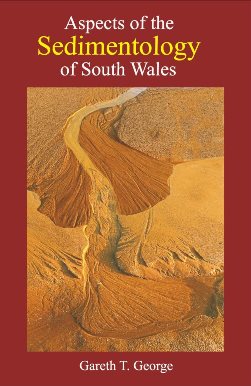 Aspects of the Sedimentology of South Wales follows Gareth George’s successful, also self-published, The Geology of South Wales: A Field Guide (2008, revised 2015). Both books are packed with detail, demanding intensive study rather than casual reading.
Aspects of the Sedimentology of South Wales follows Gareth George’s successful, also self-published, The Geology of South Wales: A Field Guide (2008, revised 2015). Both books are packed with detail, demanding intensive study rather than casual reading.
Following an introduction, one chapter covers clastic sedimentology, from petrology through sedimentary structures and facies to sequence stratigraphy. Sedimentary rock units of South Wales then appear as case studies in chapters on major depositional environments. Aeolian systems are represented by modern coastal dunes, and alluvial fans by the Ridgeway Conglomerate and Triassic fanglomerates from the Vale of Glamorgan. The variety of fluvial systems is illustrated with examples from the Old Red Sandstone and the Upper Carboniferous. Upper Carboniferous units dominate chapters on deltas (also represented from the Pleistocene of Pembrokeshire), shorelines and shelves, and estuaries and incised valleys. The Carboniferous Limestone represents shallow marine environments, and Lower Palaeozoic turbidite systems exemplify deep-sea systems.
The author demonstrates an encyclopaedic knowledge of these rock successions, derived from a career-long study in the context of research, publishing, working with industry and teaching students of all ages. Detailed figures enhance the text throughout, including photographs, annotated sketches, interpretive diagrams, graphic logs and innovative ‘mini analogues’ of ancient systems based on modern environments. Much of the content draws on unpublished material, but there is an extensive reference list, as well as a detailed index and useful appendices.
If I wanted to be picky, I could query why the overview covers just clastic sedimentology when a major chapter deals with carbonates, or whether the Upper Carboniferous really merits such dominance. But that really would be unwarranted. This book is packed with a wealth of detail. Although beginners might be daunted to learn of structures preserved “at the base of falling-stage and forced-regressive sandbodies” (p.25) and students are unlikely to need this much detail about one part of the world, anyone who wants to know the current state of understanding on the sedimentary geology of South Wales in one convenient source will be fascinated by this book with its meticulously detailed content and effective, exemplary communication.
If you love the geology of Wales, or want to plan a field course here, buy a copy. Better still, buy three or four copies - for the field, the office, the library, and at least one more for when you wear the others out.
Reviewed by Geraint Owen
ASPECTS OF THE SEDIMENTOLOGY OF SOUTH WALES by GARETH T GEORGE Published by: [email protected], 2014. 277pp, sbk. ISBN 978-0-9559371-1-8, List Price: £18.75
Dolaucothi Gold - a vision realised and Dolaucothi Gold Mines - Geology & Mining History
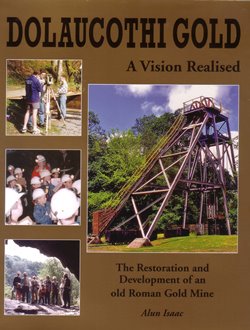 Welsh Gold has always generated interest and the Dolaucothi Gold Mines (also known as Ogofau) are probably the oldest mines in the United Kingdom. They are the only known mines outside the Dolgellau gold belt and lie about 120km north-west of Cardiff, close to the village of Pumsaint in Carmarthenshire. They have been worked periodically from Neolithic and Roman times until final closure in 1940.
Welsh Gold has always generated interest and the Dolaucothi Gold Mines (also known as Ogofau) are probably the oldest mines in the United Kingdom. They are the only known mines outside the Dolgellau gold belt and lie about 120km north-west of Cardiff, close to the village of Pumsaint in Carmarthenshire. They have been worked periodically from Neolithic and Roman times until final closure in 1940.
The site was resurrected from dereliction between 1978 and 1999 by the staff and students of the Department of Mineral Exploitation (later the School of Engineering) of the University of Cardiff. In 1999 the National Trust took over the lease and has continued the development to create today’s mining heritage site.
The two books reviewed here, although by different authors, are essentially complementary. The first describes the geological setting, the mining and mineral processing and industrial archaeological heritage of the old mining area, whilst the second gives a detailed description of the work undertaken between 1978 and 1999 to restore the abandoned mine workings and create a unique experience in the industrial heritage of Wales.
The first book, co-authored by a mining geologist and an industrial archaeologist, is a revised and expanded edition of a publication that had seen three editions since 1983, the last being in 1995. Data from work undertaken by Earth scientists and archaeologists in the succeeding period are included, together with many colour photographs and diagrams.
The text starts by presenting details of the history of the site’s ownership and a chapter placing the mineralisation in both the local and a Welsh context. The evidence of the Roman mining and ancillary operations are described followed by details of the late 19th century and early 20th Century workings. The final phases of commercial operation between 1930 and 1940, which at their peak employed up to 200 people, are described. The book finishes with a chapter covering the processing of the ores and highlights the visible remains of the processing sites and buildings.
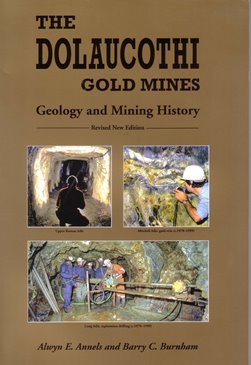 The second book covers a period of 21 years from 1978 to 1999 and describes how an initial vision of a centre for specific higher education purposes expanded to the creation of an educational centre for the local community and visitors of all ages and levels of knowledge and experience.
The second book covers a period of 21 years from 1978 to 1999 and describes how an initial vision of a centre for specific higher education purposes expanded to the creation of an educational centre for the local community and visitors of all ages and levels of knowledge and experience.
Work on the site is divided into three phases each of which forms a chapter. The first, from 1978 to 1984, covers the initial rehabilitation of the abandoned workings and describes the work done, how it was progressed and who was involved. The second, from 1984 to 1988, includes the use of the mine as an educational facility for both teaching and research and looks at further developments which included the installation of 1930s surface buildings and equipment salvaged from a closed mine in North Wales. The final phase, from 1988 to 1999, covers later developments at the site and looks at the significant changes from a site used by a limited group from the University of Cardiff to one of much wider use and interest.
These books will be a fascinating and nostalgic read for many, and for those less familiar with the mines, certainly the first will be an essential read for anyone considering a visit to the area.
Reviewed by Stephen Cribb
THE DOLAUCOTHI GOLD MINES – GEOLOGY AND MINING HISTORY by ANNELS, ALWYN E & BURNHAM, BARRY C (2013) Caerleon: APECS Press. 99pp ISBN 978-0-9563965-5-6 List price: £12.50 pbk W: www.apecspress.co.uk
DOLAUCOTHI GOLD – A VISION REALISED by ISAAC, ALUN. (2012) Caerleon: APECS Press. 200pp ISBN 978-0-9563965-2-5 List price: £12.50 pbk.W: www.apecspress.co.uk
On the edge - coastlines of Britain
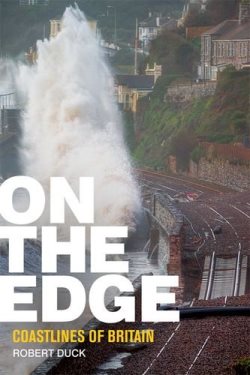 This book summarises the development of the railways around the coastline of Britain since the beginning of all rail development. The book examines how railway lines have influenced and altered the physical landscape of our coastline.
This book summarises the development of the railways around the coastline of Britain since the beginning of all rail development. The book examines how railway lines have influenced and altered the physical landscape of our coastline.
Written in a very readable style and not an academic treatise, it provides plenty to think about. The only significant weakness is the lack of maps to illustrate the often very detailed descriptions of how railways were constructed and impacted on our coast.
For any environmentalist the first part of the book is a stark illustration of how uncontrolled development can have serious detrimental effects on ecosystems, the landscape/seascape, the health of coastal communities, and the economic activities that our ancestors carried out. Therefore the book is a strong advocate (albeit silently) for the rigour of thorough environmental impact assessments of new railway developments.
Today, we take rail safety extremely seriously, but it is clear that this was not always the case. Some startling facts and figures are presented about the poor safety record of early rail travel, not all due to operational or design failures. Many were due to poor route selection that took little account of geological setting. Numerous incidences of landslips/landslides and washouts along the coastal railway lines are documented, many resulting in fatalities.
The final part of the book looks at the impact that access by rail to beaches has had on our coastline. There are some fascinating accounts of how taking beach sand and gravels for construction (often of the railways themselves) has resulted in complete changes to the coastal hydrodynamics. As we now know, changes to coastal flow regimes are never something to be carried out without considerable care and forethought. For decades there was no control over removing beach materials; but slowly, control was brought to these practices. Yet local authorities were often the worst offenders, trying to maintain their beaches and rail access without caring about the impact of their beach construction/mining might have on communities elsewhere along the coast.
All in all, a fascinating, valuable and worthwhile book that will be of interest to rail engineers, geologists and environmentalists.
Reviewed by James Montgomery
ON THE EDGE, COASTLINES OF BRITAIN by ROBERT DUCK. Published by: Edinburgh University Press 2015 ISBN : 978-0-7486-9762-5. W: www.euppublishing.com
Upstream Petroleum
 Petroleum economics is a vital tool for companies, investors and governments whether the oil price is US$37/bbl (end 2015) or US$110/bbl (when this book was published). Economic modelling is used by companies to assist in or determine investment decisions. On the other side of the contractual fence, modelling is used by governments to determine the fine balance between extracting enough ‘rent’ from companies while still make their country an attractive investment opportunity.
Petroleum economics is a vital tool for companies, investors and governments whether the oil price is US$37/bbl (end 2015) or US$110/bbl (when this book was published). Economic modelling is used by companies to assist in or determine investment decisions. On the other side of the contractual fence, modelling is used by governments to determine the fine balance between extracting enough ‘rent’ from companies while still make their country an attractive investment opportunity.
The third use of economics is for the benefit of investors in oil and gas companies to determine the value of the assets owned by the company (conducted by the company or a contracted third party). This is one area the industry could improve. How often do companies claim their assets are worth billions of dollars and a concomitant volume of oil? Part of the problem lies with the role of the independent contractor - supplied with data and guided by the company - used to determine the worth of assets in a competent person’s report. The authors recognise this issue, urging readers to be nascent economists in the treatment of abandonment and income tax towards the end of field life.
The authors have adopted a practical approach to the subject. Much of the book is about cell formulation within spreadsheets to correctly reflect contractual arrangements. This approach does not make for good reading (as the authors warn!). The book takes on the appearance of the transcription from a taught course comprising abundant bullet-pointed text.
Getting the spreadsheet cells functioning correctly to reflect contract terms is one aspect of the book that is very thorough. However, even if the model works correctly the results might be meaningless unless the assumptions are based on some reality. The authors hammer home the point of ensuring that all input is properly audited and checked by a relevant expert. Optimistic production profiles, low costs and a positive oil or gas price outlook can do wonders for the valuations of assets.
This book bears resemblance in style to a Haynes Manual rather than an academic treatise, but just as a Haynes manual does not make the user a mechanic, this book will not make the reader a petroleum economist. Recently, I needed some help on a model and plunged into the book seeking solutions – I could not find the solution. The book is expensive and needs heavily discounting to reflect what is required in the industry – severe cost reduction!
Reviewed by Stephen Crabtree
UPSTREAM PETROLEUM FISCAL AND VALUATION MODELING IN EXCEL: A WORKED EXAMPLES APPROACH by KEN KASRIEL & DAVID WOOD, 2013. Published by John Wiley & Sons, 344pp (plus CD with supporting EXCEL models) (hbk) ISBN 9780470686829 List Price £100 W: www.eu.wiley.com/WileyCDA/WileyTitle/productCd-0470686820.html
Beyond Governments - making collective governance work
 The Extractive Industries Transparency Initiative (EITI) was born in 2003 to try to reconcile the flow of funds between the extractive industries and the recipient government. The first criterion of EITI was that there should be "Regular publication of all material oil, gas and mining payments by companies to governments and all material revenues received by governments from oil, gas and mining companies to a wide audience in a publicly accessible, comprehensive and comprehensible manner.
The Extractive Industries Transparency Initiative (EITI) was born in 2003 to try to reconcile the flow of funds between the extractive industries and the recipient government. The first criterion of EITI was that there should be "Regular publication of all material oil, gas and mining payments by companies to governments and all material revenues received by governments from oil, gas and mining companies to a wide audience in a publicly accessible, comprehensive and comprehensible manner.
EITI's emphasis on the oil, gas and mineral sectors is the primary reason why this initiative should be of interest to Earth Scientists. The magnitude and consequences of the challenge are quite staggering. After 10 years of EITI reporting, Nigeria received US$9 billion more revenue than would have been the case before EITI reporting. The authors estimate that as a consequence of the improvement in accounting principles, four African states’ revenue may see revenues replacing aid within the space of one more electoral cycle.
The initiative has involved representatives from diverse sectors of society, each of which had different perspectives on the challenge. Citizens wanted a better deal and to participate in policy discussions; governments wanted more revenue and investment and to polish their reputation, and companies wanted a more predictable environment in which to operate and demonstrate their social and economic contribution.
The authors propose that the EITI principles can be usefully applied where there is a problem in which there is a wide range of opinions and no consensus. They suggest that review of international financial flows might benefit from this approach (illicit flows from Africa amounted to US $865 billion between 1970 and 2008). They even note the use of these principles with respect to the conflict in Syria as an example.
I wonder whether it might work for Climate Change. The challenge seems to me to be to get potential participants to recognise that there is a situation in which a novel approach might work. Whatever the application, the authors repeatedly stress that one should start small to build trust between participants, and that the product rather than the process should be foremost.
It is a short book, easily read, and there are good summaries at the end of each chapter.
Reviewed by Richard Haworth
BEYOND GOVERNMENTS: MAKING COLLECTIVE GOVERNANCE WORK - LESSONS FROM THE EXTRACTIVE INDUSTRIES TRANSPARENCY INITIATIVE, by EDDIE RICH & JONAS MOBERG (Eds) 2015. Published by: Greenleaf Publishing 153pp (sbk) ISBN: 139781783531851 List Price: £20 W: www.greenleaf-publishing.com
Lost Antarctica - adventures in a disappearing land
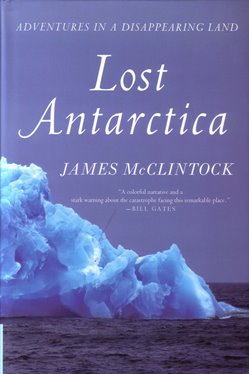 This book describes some of the changes that have occurred in Antarctica over the last 50 years or so. Written for a popular audience, it is based on research and experiences of the author, his colleagues and collaborators in Antarctic marine chemical ecology and, more recently, studies of the impacts of a rapidly changing climate on marine plants, animals and communities of the Antarctic Peninsula. The author has made 14 research visits to Antarctica – to the Kerguelen Islands, nine consecutive expeditions to McMurdo Sound and latterly to the US Palmer Station and the Antarctic Peninsula.
This book describes some of the changes that have occurred in Antarctica over the last 50 years or so. Written for a popular audience, it is based on research and experiences of the author, his colleagues and collaborators in Antarctic marine chemical ecology and, more recently, studies of the impacts of a rapidly changing climate on marine plants, animals and communities of the Antarctic Peninsula. The author has made 14 research visits to Antarctica – to the Kerguelen Islands, nine consecutive expeditions to McMurdo Sound and latterly to the US Palmer Station and the Antarctic Peninsula.
Descriptions of fieldwork events and the wildlife give a fascinating insight into the life of an Antarctic scientist and will bring back memories for those who have been lucky enough to visit or work in Antarctica. Interspersed with the main message of the book about the effects of climate change on Antarctica, which has notes referencing both journal and popular press articles, they provide an excellent leavening to the science.
Eight chapters cover different aspects starting with a broad introduction to Antarctic research, followed by the importance of ice and how it is being affected. Since the opening of Drake Passage between Antarctica and South America 30-40 million years ago, the Antarctic Circumpolar Current has isolated the continent and played an important role in regulating global climate. However, this has migrated southwards since the 1950s and dramatic increases in temperature, particularly in the Antarctic Peninsula, have led to the break-up of ice shelves and accelerated flow of glaciers into the sea. Then come planktonic and sea-floor communities, ocean acidification, the invasion of king crabs, introducing a crushing predator to Antarctic seas, the decline of Adélie penguins and southward march of sub-Antarctic species.
The book warns that, by 2100, there will be no annual sea ice in the central and northern parts of the Western Antarctic Peninsula, no Adélie penguins, krill replaced by far less nutritious salps in the plankton, with sea-floor organisms threatened by rising temperatures, ocean acidification and invading king crabs, leading to the loss of defensive chemicals that kill pathogens and ward off predators, including some with biomedical potential.
The importance of Antarctica in discoveries related to climate change and atmospheric science is emphasised. Ice cores going back 720,000 years show cyclic fluctuation in CO2 content peaking at 280-300ppm and ozone depletion caused by CFCs was discovered here. This may provide an element of hope since the 1987 Montreal protocol has successfully stopped the depletion and ozone levels in the stratosphere are expected to return to 1980 levels by 2045 to 2060 – an exemplar of international cooperation for action on climate change.
I thoroughly enjoyed this fascinating book with its mixture of popular anecdotes and thorough well-referenced science.
Reviewed by David Brook
LOST ANTARCTICA: ADVENTURES IN A DISAPPEARING LAND by JAMES MCCLINTOCK, 2012. New York, Palgrave Macmillan, 231pp. ISBN 978-0-230-11245-2. $26.00/$30.00Can. W: www.us.macmillan.com/lostantarctica/jamesmcclintock